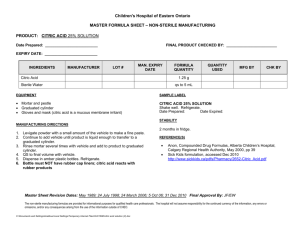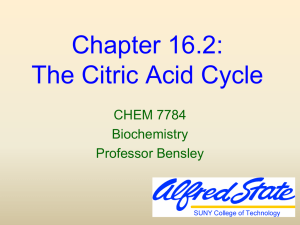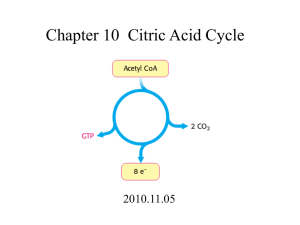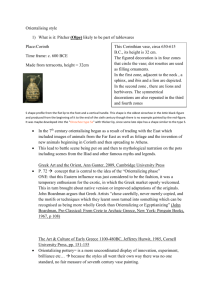Current Research Journal of Biological Sciences 4(4): 427-436, 2012 ISSN: 2041-0778
advertisement
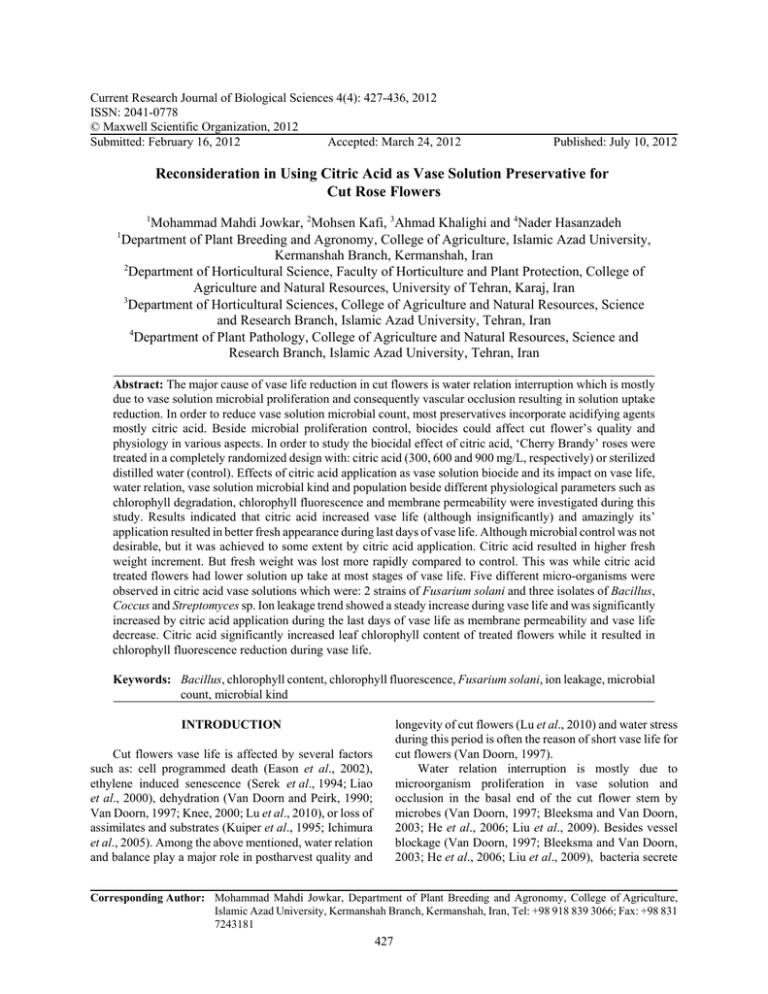
Current Research Journal of Biological Sciences 4(4): 427-436, 2012 ISSN: 2041-0778 © Maxwell Scientific Organization, 2012 Submitted: February 16, 2012 Accepted: March 24, 2012 Published: July 10, 2012 Reconsideration in Using Citric Acid as Vase Solution Preservative for Cut Rose Flowers 1 Mohammad Mahdi Jowkar, 2Mohsen Kafi, 3Ahmad Khalighi and 4Nader Hasanzadeh Department of Plant Breeding and Agronomy, College of Agriculture, Islamic Azad University, Kermanshah Branch, Kermanshah, Iran 2 Department of Horticultural Science, Faculty of Horticulture and Plant Protection, College of Agriculture and Natural Resources, University of Tehran, Karaj, Iran 3 Department of Horticultural Sciences, College of Agriculture and Natural Resources, Science and Research Branch, Islamic Azad University, Tehran, Iran 4 Department of Plant Pathology, College of Agriculture and Natural Resources, Science and Research Branch, Islamic Azad University, Tehran, Iran 1 Abstract: The major cause of vase life reduction in cut flowers is water relation interruption which is mostly due to vase solution microbial proliferation and consequently vascular occlusion resulting in solution uptake reduction. In order to reduce vase solution microbial count, most preservatives incorporate acidifying agents mostly citric acid. Beside microbial proliferation control, biocides could affect cut flower’s quality and physiology in various aspects. In order to study the biocidal effect of citric acid, ‘Cherry Brandy’ roses were treated in a completely randomized design with: citric acid (300, 600 and 900 mg/L, respectively) or sterilized distilled water (control). Effects of citric acid application as vase solution biocide and its impact on vase life, water relation, vase solution microbial kind and population beside different physiological parameters such as chlorophyll degradation, chlorophyll fluorescence and membrane permeability were investigated during this study. Results indicated that citric acid increased vase life (although insignificantly) and amazingly its’ application resulted in better fresh appearance during last days of vase life. Although microbial control was not desirable, but it was achieved to some extent by citric acid application. Citric acid resulted in higher fresh weight increment. But fresh weight was lost more rapidly compared to control. This was while citric acid treated flowers had lower solution up take at most stages of vase life. Five different micro-organisms were observed in citric acid vase solutions which were: 2 strains of Fusarium solani and three isolates of Bacillus, Coccus and Streptomyces sp. Ion leakage trend showed a steady increase during vase life and was significantly increased by citric acid application during the last days of vase life as membrane permeability and vase life decrease. Citric acid significantly increased leaf chlorophyll content of treated flowers while it resulted in chlorophyll fluorescence reduction during vase life. Keywords: Bacillus, chlorophyll content, chlorophyll fluorescence, Fusarium solani, ion leakage, microbial count, microbial kind longevity of cut flowers (Lu et al., 2010) and water stress during this period is often the reason of short vase life for cut flowers (Van Doorn, 1997). Water relation interruption is mostly due to microorganism proliferation in vase solution and occlusion in the basal end of the cut flower stem by microbes (Van Doorn, 1997; Bleeksma and Van Doorn, 2003; He et al., 2006; Liu et al., 2009). Besides vessel blockage (Van Doorn, 1997; Bleeksma and Van Doorn, 2003; He et al., 2006; Liu et al., 2009), bacteria secrete INTRODUCTION Cut flowers vase life is affected by several factors such as: cell programmed death (Eason et al., 2002), ethylene induced senescence (Serek et al., 1994; Liao et al., 2000), dehydration (Van Doorn and Peirk, 1990; Van Doorn, 1997; Knee, 2000; Lu et al., 2010), or loss of assimilates and substrates (Kuiper et al., 1995; Ichimura et al., 2005). Among the above mentioned, water relation and balance play a major role in postharvest quality and Corresponding Author: Mohammad Mahdi Jowkar, Department of Plant Breeding and Agronomy, College of Agriculture, Islamic Azad University, Kermanshah Branch, Kermanshah, Iran, Tel: +98 918 839 3066; Fax: +98 831 7243181 427 Curr. Res. J. Biol. Sci., 4(4): 427-436, 2012 pectinases and toxic compounds and produce ethylene (Williamson et al., 2002), thereby, accelerate senescence. Beside vase life reduction, disruption of water relation in rose flowers causes some physiological disorders such as bent neck (Van Doorn and Peirk, 1990; Florack et al., 1996; Bleeksma and Van Doorn, 2003), lack of flower opening (Bleeksma and Van Doorn, 2003) and wilting of the leaves accompanied by improper opening and wilting of flowers (Torre and Fjeld, 2001; Bleeksma and Van Doorn, 2003). Therefore, controlling and reducing microbial proliferation is a prerequisite for extendending quality and longevity of cut flowers, especially roses. On the other hand applied biocides could also severally or moderately affect other physiological properties of cut flowers specially their photosynthetic apparatus function and membrane permeability by their toxic compounds during aging and senescence. In order to prevent vase solution microbial count and proliferation, most preservatives incorporate acidifying agents. One of the most widely and commercially used acidifying agent has been citric acid. This is while citric acid application has not been comprehensively studied and important physiological responses of cut flowers to biocide application such as chlorophyll degradation, chlorophyll fluorescence and membrane permeability have been unseen. In this study we have tried to focus on some of the mentioned physiological properties beside biocidal efficacy with the intention of considering citric acid for large scale application as vase solution preservative. Therefore its impact on vase life, water relation, vase solution microbial kind and population beside different physiological parameters such as chlorophyll degradation, chlorophyll fluorescence and membrane permeability during postharvest life of ‘Cherry Brandy’ rose have been studied. vase solutions were: citric acid (300, 600 and 900 mg/L, respectively), or sterilized distilled water (control). Experimental condition: Cut rose flowers were kept in a laboratory with a maximum and minimum temperature of 25±2 and 21±2ºC, respectively; Relative Humidity (RH) of 55±5% and light intensity of 4 :moL/m2/s provided by white fluorescent lamps from 07.00 to 20.00 h. Vase life and side effect evaluation: During vase life evaluation, cut rose flowers were daily checked and their appearance and condition were recorded to determine the vase life and if the applied chemicals had any side effects. Termination of vase life was recorded when wilting of the outer 5 petals occurred or bent neck was observed (Bleeksma and van Doorn, 2003). Microbial count: Microbial count was determined by taking 1 mL vase solution samples during the first 6 days of the experiment, at 2 days intervals with 3 replications. One mL from each sample was diluted in 10 fold serial dilution. (0.1 mL) from each concentration of diluted samples was plated on nutrient agar and all were incubated at 35ºC for 48 h. Microorganisms were counted by standard plate counting method (by counting the number of colonies formed after incubation) to generate the number of Colony Forming Units/mL (CFU/mL) (Jowkar, 2006). Microbe growth rate: Microbe Growth Rate (MGR) was calculated as: MGR = Log10 ((Mt-Mt-1)/ Mt-1); where Mt is the microbe count on the measuring day (in this experiment: t = 4 and 6) and Mt-1 is the microbe count on previous measuring day. Microbial identification: After plate counting, obtained colonies were studied and separated by their apparent morphological differences. This resulted in 2 fungi and 4 bacterial isolates. Fungi were cultured on Potato Dextrose Agar and after incubation; they were identified according to their morphological characteristics according to Steinkellner and Langer (2004) and Siddiquee et al. (2009). The bacterial isolates were purified and then differentiated according to their typical morphological and biochemical characteristics (Schaad et al., 2001; Janse, 2005). MATERIALS AND METHODS Plant material: Rose (Rosa × hybrida) cv. ‘Cherry Brandy’ (licensed by Rosen Tantau, Germany) were harvested at commercial maturity stage (i.e. outer petals starting to reflex and inner petals have become visible) during summer 2010 from rose plants grown in hydroponic perlite in an automatic greenhouse, Kermanshah, Iran. Flowers were harvested early in the morning and transferred to laboratory within 1 h after harvest. Before treatment, all the leaves except the 5 most upper leaves of each flower stem were removed and then stems were recut slantly under water so that all flowers reach a height of 40 cm and probable air emboli gets removed. Bacterial morphological studies were: motility, cell shape and capsule presence. Bacterial bioassays were: potato soft rot and hypersensitivity test on tobacco. The biochemical tests carried out on isolated bacterial colonies were: gram reaction using KOH, aerobic/anaerobic growth, acid production from glucose, gas production from D-glucose, fluorescent pigments production on KB, oxidase test, catalase test, gelatin hydrolysis, levan, Experimental design and treatments: Following recut, flowers were treated in a completely randomized design of 4 treatments and 9 replications. Treatments applied as 428 Curr. Res. J. Biol. Sci., 4(4): 427-436, 2012 :moL/m2/s. Fv is the difference between F0 and Fm (Maxwell and Johnson, 2000; Tambussi et al., 2004). growth at 50ºC, growth at 5.7 pH, starch hydrolysis, tween 80 hydrolysis, indol production, methyl red reaction, aceteoin (VP), nitrate reduction, arginine dihydrolase and H2S production from cysteine (Schaad et al., 2001; Janse, 2005). Statistics: Data were analyzed by one way ANOVA using MSTAT-C software and means were compared by the Least Significant Difference (LSD) test at the 0.05 and 0.01 probability level (p = 0.05 and 0.01). The correlation between solution uptake, relative fresh weight, pH and microbial count was computed using SPSS 16.0 software. Fresh weight changes: In order to record fresh weight changes of cut flowers, flower stems were weighted by a balance on a daily basis. Data were obtained to calculate fresh weight changes and consequently Relative Fresh Weight (RFW) changes of the stems (Jowkar, 2006). Relative fresh weight was calculated as: RFW (%) = (Wt/Wt0)×100; where, Wt is weight of stem (g) at t = day 0, 1, 2, etc. and Wt0 is weight of the same stem (g) at t = day 0 (He et al., 2006; Liu et al., 2009). RESULTS AND DISCUSSION Vase life: Although application of citric acid increased vase life of ‘Cherry Brandy’ roses in our experiment, the increment was not significant (Table 1). With citric acid concentration increment vase life decreased. Consequently the highest vase life belonged to the lowest citric acid concentration (i.e., 300 mg/L). Similar to our findings, Ketsa and Narkuba (2001) found that by reducing the pH of 5% sucrose solution to 2.9 by adding citric acid, no significant effect on vase life of different cut roses was seen. Solution uptake: Solution uptake of flowers was measured using a balance by weighting each vase containing its solution without its flowers and correcting the evaporation from the 4 evapo-control vases by subtracting the average of 4 evaporation data from solution uptake on a daily basis. Daily vase solution uptake was calculated as: vase solution uptake rate (g/stem/day) = (St-1-St); where, St is weight of vase solution (g) at t = day 1, 2, 3, etc. and St-1 is weight of vase solution (g) on the previous day (Jowkar, 2006; He et al., 2006; Liu et al., 2009). Side effects: Even at high concentration (900 mg/L), citric acid application did not result in any harm to cut ‘Cherry Brandy’ rose flowers and no side effects were observed on treated flowers. Instead, flowers has a fresh appearance until the last days of vase life and leaves of the flower stems were turgid and fresh even 2 days after vase life termination. This is while in most biocide studies, flower toxicity or side effects has been reported in which some cases vase life reduction has been reported as a side effect (Van Doorn et al., 1990; Knee, 2000; Jowkar, 2006). Ion leakage: Three 2.5 cm diameter discs were taken from leaf of each treatment’s flower stalk and placed into 50 mL centrifuge tubes containing 20 mL of 2 bar mannitol solution. Samples were kept at 25ºC and dark for 24 h after which electric conductivity was measured and solution’s initial electric conductivity was subtracted in order to obtain electrolyte leakage. Microbial count: Although there was not a significant difference between citric acid treatments, but as seen in Table 2, with concentration increment microbial count was reduced by citric acid application. This resulted in a significant difference between citric acid treatments and control. At day-2 the vase solution contamination level in control was more than 4 folds compared to citric acid. Although at day 4 there was still a significant difference between citric acid treatments and control, but the difference was not much. This showed that citric acid efficacy was rapidly lost during the first 4 days. On day-6 a significant difference in contamination level between treatments was observed and a completely different trend was seen. With concentration increment, microbial count decreased. It seems that in higher concentration microbial proliferation was more efficiently controlled and citric acid and pH interaction has prevented microbial proliferation above a certain limit. Most vase preserving solutions contain a pH reducing compound (Nowak and Rudnicki, 1990). Van Doorn Chlorophyll content: Total chlorophyll content was measured by non destructive method using chlorophyll meter (SPAD-502, Minolta Co., Japan) which provides a SPAD value (Zamani et al., 2011). Measurement was conducted with 2 day intervals on 4 different flower stems (replications) in each treatment. For each flower stem, measurement was conducted on the marked spot of distal leaflet of 3 leaves. Chlorophyll fluorescence: The quantum efficiency of open photo system II centers (Fv/Fm = ratio of variable to maximum fluorescence), was measured by a nondestructive method every 2 days with a Opti-Sciences OS-5P pulse amplitude fluorimeter (Opti-Sciences INC., Hudson, NH, USA) (Maxwell and Johnson, 2000). Leaves were maintained in darkness for 20 min by a special clip before measurement of Fv/Fm. Minimal fluorescence (F0) was measured under a weak pulse of modulating light over a 0.8 s period and maximal Fluorescence (Fm) was obtained after a saturating pulse of 0.7 s at 8000 429 Curr. Res. J. Biol. Sci., 4(4): 427-436, 2012 Table 1: Effect of citric acid on vase life of cut ‘Cherry Brandy’ rose Treatment Vase life (day) Citric acid 300 mg/L 12.44 a† Citric acid 600 mg/L 11.56 a Citric acid 900 mg/L 11.78 a Sterilized distilled water (control) 11.67 a † : Means followed by the same lower-case letters are not significantly different at the 0.01 probability level using Least Significant Difference (LSD) test it has acted as a source of energy by the bacteria and has helped them to proliferate. During the second phase a completely different pattern was seen (Table 3). During the second phase, with citric acid concentration increment, microbial growth rate decreased. This could be explained by either: C C C Table 2: Effect of citric acid on cut ‘Cherry Brandy’ rose vase solution microbial count during days 2, 4, 6 Microbial count† (log10 CFU/mL)†† --------------------------------------------Treatment Day-2 Day-4 Day-6 Citric acid 300 mg/L 1.690 b††† 5.918 b 8.505 b Citric acid 600 mg/L 1.151 b 5.800 b 7.318 c Citric acid 900 mg/L 1.151 b 5.792 b 6.778 d Sterilized distilled water (control) 4.477 a 6.469 a 9.203 a † : Microbe counts, except a zero count, are reported as log10x (x = microbe counts); ††: The number of microorganisms was counted by the standard plate counting method and expressed as Colony Forming Units/mL (CFU/mL); †††: Means followed by the same lower-case letters are not significantly different at the 0.01 probability level using Least Significant Difference (LSD) test Depletion of substrate (citric acid) Increase in pH Reaching the bacterial population limit of citric acid solution (which is achieved by compound-pH interation) The first two mentioned are rejected as they did not happen. Our results support the last hypothesis. Although during the second growth phase there was a significant difference between all citric acid treatments, but considering final growth rate, there was only a significant difference between 300 and 900 mg/L treatments. As microbial growth rate shows which treatment loses it efficiency faster compared to the rest or which treatment is more efficient throughout the experiment, we conclude that 900 mg/L treatment of citric acid is the best treatment from this point of view as it had the most constant and high anti-bacterial effect. (1998) has showed that low pH prevents vascular blockage in cut rose stems by reducing the bacterial population in the vase solution. As same as Van Doorn (1998), we had a partial proliferation control by citric acid, but the control was not so efficient. Even by reducing the pH of vase solution bellow 2.7 (in 900 mg/L citric acid) (Table 2), we still had a considerable microbe count. Our results indicate that although decreasing pH will reduce microbial contamination, but this reduction by concentration increment will only be to some extent. In other words, reducing pH will result in a proliferation limit and not disinfection. This is why Van Doorn et al. (1990) concluded that at none toxic concentrations none of the applied compounds had constant and high antibacterial effect and that previous studies have reported effective concentrations of biocides can be toxic to many flowers (Van Doorn et al., 1990; Knee, 2000; Jowkar, 2006). pH effect on microbial count: In citric acid treatments, there was a significant correlation between pH of citric acid solutions and microbial count (Table 4). Indicating that with decrease in pH, by increasing citric acid concentration, microbial population decreases with a significant correlation. This is in accordance with cut flower preserving solution recommendations; that is: by decreasing (acidifying) vase solution pH, microbial proliferation is controlled (Nowak and Rudnicki, 1990). For microbial growth, there was also a similar correlation in citric acid treatments (Table 4). With decrease in pH, there was a decrease in microbial growth. Microbial kind: In the vase water of cut roses, many different kinds of bacteria, yeasts and fungi have been identified (De Witte and Van Doorn, 1988; Put, 1990). In the vase solution of this experiment 6 different micro organisms were observed which were 2 fungi and 4 bacterial isolates. This is while in carnation vase solution Zagory and Reid (1986) identified 25 different microorganisms. It seems that fewer microbe types were due to lower flower contamination which was achieved by integrated management applied during flower production. The isolated fungi were two different strains of Fusarium solani which were seen in citric acid solutions. This was while in an experiment on Narcissus tazetta, the only fungus found in citric acid vase solution was Microbial growth rate: Although control treatment had the highest contamination level, but as seen in Table 3, its microbial growth rate was the least throughout the experiment. Actually this doesn’t show the beneficial effect of this treatment as it was a result of high initial contamination. In citric acid treatment during the first growth phase, microbial growth rate increased with concentration increment. This implies that instead of preventing microbial growth, citric acid has increased microbial proliferation as mentioned before. We explain this by the nutritious value of citric acid. It seems that citric acid has been conjugated by vase solution bacteria and has been converted to citrate which is a substrate of Kerbs Cycle (Rich, 2003; Jones et al., 2000) and therefore 430 Curr. Res. J. Biol. Sci., 4(4): 427-436, 2012 Table 3: Effect of citric acid on cut ‘Cherry Brandy’ rose vase solution microbial growth rate Microbial growth rate† (log10 CFU/mL)†† --------------------------------------------------Phase 1 Phase 2 Final growth Treatment growth rate growth rate rate 6.816 a Citric acid 300 mg/L L4.229 a††† 2.585 a Citric acid 600 mg/L 4.650 a 1.503 b 6.167 ab Citric acid 900 mg/L 4.641 a 0.939 c 5.628 b Sterilized distilled 1.987 b 2.734 a 4.726 c water (control) † : Microbe counts, except a zero count, are reported as log10x (x = microbe counts); ††: The number of microorganisms was counted by the standard plate counting method and expressed as Colony Forming Units/mL (CFU/mL); †††: Means followed by the same lower-case letters are not significantly different at the 0.01 probability level using Least Significant Difference (LSD) test was observed. On the other hand Actinomycetes were one of the most broad spread microorganisms in narcissus citric acid vase solution, which were then substituted by Bacillus sp. (Jowkar, 2006). Depending on experiment condition and production system, other dominant types of bacteria have been seen. For example, Van Doorn et al. (1995) found Pseudomonas species as the dominant microorganism in roses and carnation cut flowers. Agricultural products microbial flora and population are determined by the products physiological condition and mixture of bacteria, yeasts and fungi covering the product (Zagory, 1999). It has been proved that when cut flowers are placed in vase, bacteria from flower surface transfer to vase solution. For example, Van Doorn and De Witte (1997) recognized that Bacillus and Staphylococcus xylosus transfer from leaves and stems of cut ‘Sonia’ roses into vase solution. Other sources of microbial contamination are vase water, contaminated vases, containers, or vessels (Hoogerwerf and Van Doorn, 1992). These facts explain the difference between the microbial contamination in our study and others. Table 4: Correlation between pH of citric acid and microbial growth of ‘Cherry Brandy’ rose vase solution Log growth Log growth Log final Correlation phase 1 phase 2 growth pH 0.861* 0.835 0.842* *: Correlation is significant at the 0.05 level Aspergillus sp. (Jowkar, 2006). Indicating that citric acid in not capable of efficiently preventing fungus growth. Generally, our experiments findings indicate that most of the microorganisms in the vase solutions were bacteria, which is consistent with other published data (De Witte and Van Doorn, 1988; Put, 1990; Florack et al., 1996; Jowkar, 2006). Among the 6 different separated bacterial colonies, 2 were Bacillus, 1 was Coccus and one colony was Streptomyces sp. This is while in previous studies other different bacterial strains were seen. For example, bacterial strains found in rose stems by Van Doorn et al. (1991) were: Pseudomonads (80%), Enterobacteria (5-10%); and some other genera such as Aeromonas, Acinetobacter, Alcaligenes, Citrobacter and Flavobacterium which occurred infrequently. In another study they had Pseudomonads and Enterobacteria as the dominant bacterial strains in stems of cut ‘Sonia’ roses (van Doorn and de Witte, 1997). Other isolated bacteria from rose vase solution were Fluorescent Pseudomonad and a Nonfluorescent Pseudomonad which reduced flower vase life of cut Rosa hybrida cv. ‘Cara Mia’ (Zagory and Reid, 1986). Sterilized distilled water (Control) was only contaminated with Bacillus sp. bacteria while citric acid vase solutions showed more diversity and were contaminated with one isolate of Bacillus polymexa, one isolate of Streptomyces sp. and one isolate of Coccus. In previous studies, Bacillus has been the most common occurring vase solution microorganism (De Witte and van Doorn, 1988; Put, 1990; Ketsa et al., 1995; Jowkar, 2006). This was while the most spread bacteria in ‘Cherry Brandy’ citric acid solutions were Coccus and Streptomyces sp., after which a colony of B. polymexa Weight changes: During the first five days of experiment relative fresh weight of all treatments showed an increasing trend (Fig. 1). Between treatments higher concentrations of citric acid (600 and 900 mg/L) resulted in better weight gain in cut ‘Cherry Brandy’ rose flowers. From day 5 onwards fresh weight showed a decreasing trend in all treatments. Although highest weight gain belonged to 600 mg/L citric acid, but between all the treatments, control showed the best fresh weight retention and therefore resulted in the least fresh weight loss at the end of vase life. Between different citric acid treatments, 600 mg/L was recognized as an optimum level as it resulted in the highest fresh weight gain and retention throughout the experiment. Knee (2000) observed that some biocides do not increase fresh weight gain, but actually a number of them inhibited it. This was while we saw citric acid increases fresh weight during the first days of experiment but it is not able to sustain its effect and loses its efficacy in retaining fresh weight from day-6 (Fig. 1). While Van Meeteren et al. (2000) observed a decrease in fresh weight of their control (deionized treated) cut flowers during the first 1-3 days of vase life. We did not seen such a trend in our control treated flowers; instead they reached their maximum fresh weights on day-4. Solution uptake: There was a high solution uptake in all treatments on day-1 (Fig. 2) after which there was a decrease. At most stages throughout the experiment, control flowers had the highest solution uptake. This was more evident during the first 4 days of experiment and especially at the end of vase life. Although at most stages solution uptake in sterilized distilled water treated flowers 431 Fresh weight change (% of inltlal) Curr. Res. J. Biol. Sci., 4(4): 427-436, 2012 Citric acid 300 Citric acid 600 130.00 Table 5: Correlation between Relative Fresh Weight (RFW) and Solution Uptake (SUT) of ‘Cherry Brandy’ rose Correlation Day 2 Day 4 Day 6 Day 12 RFW-SUT 0.438** 0.709** 0.865** 0.655** **: Correlation is significant at the 0.01 level Citric acid 900 D-W 125.00 120.00 115.00 Considering this fact that control solution had a higher microbe population while it also resulted in the most solution uptake, indicates that 105.00 100.00 95.00 90.00 C 85.00 0 1 2 3 4 5 6 7 8 9 10 11 12 13 Vase life (days) C Solutlon uptake (g stem-1day -1) Fig. 1: Relative fresh weight trend of cut ‘Cherry Brandy’ rose flowers treated with citric acid. There is a general sharp increase in relative fresh weight during the first days of the experiment. After reaching a maximum point there is a reduction until vase life termination Citric acid 300 Citric acid 600 24.00 Correlation between solution uptake, relative fresh weight and microbial count: Various researches have indicated different microbial contamination levels for solution uptake rate reduction. For ‘Charlotte’ rose it has been shown that inclusion of 1011 CFU/mL bacteria in the vase water significantly reduced rates of water uptake (Macnish et al., 2008). On the other hand, Van Doorn (1997) has mentioned that for various flower species, when 105-108 CFU/mL bacteria is added to vase water it caused a reduction in water uptake. But in our study, correlation analysis between solution uptake, relative fresh weight and microbial count on days 2, 4 and 6 indicated that there is not a significant correlation between solution uptake and microbial count on the mentioned days. This is while Jowkar (2006) found a weak negative correlation between microbial count and average solution uptake for Narcissus. tazetta L. cv. ‘Shahla-e-Shiraz’. As mentioned before we believe that proliferated microbe kind is the main reason for this issue. On the other hand, as expected, there was a significant correlation at 0.01 level between solution uptake and relative fresh weight on days 2, 4, 6 and 12 in our study (Table 5). This is in accordance with Knee (2000) findings. He observed that maximum weight gain and solution uptake were correlated. Citric acid 900 D-W 20.00 16.00 12.00 8.00 4.00 0 1 2 3 4 Bacillus proliferated microbes did not prevent solution uptake compared to proliferated microbes in citric acid treatments although their count was higher Solution uptake reduction in citric acid treatments is due to other factors such as microbe kind not to microbe count. 5 6 7 8 9 10 11 12 13 Vase life (days) Fig. 2: Vase solution uptake trend of cut ‘Cherry Brandy’ rose flowers treated with citric acid. There is a high solution uptake in all treatments on day-1. After that, there are 2 critical points of maximum solution uptake which all treatments follow was higher than citric acid but there was not a significant difference between them throughout the experiment. This is while Jowkar (2006) saw the highest solution uptake by Narcissus tazetta flowers in 150 mg/L citric acid treatment and that citric acid treatments had higher solution uptake compared to control. Although solution uptake in previous studies tended to increase initially and then decrease (Knee, 2000; Jowkar, 2006), throughout our experiment there were 3 critical points of maximum solution uptake which all treatments followed (Fig. 2). Those days were day-1, 6 and 12. The highest solution uptake on day-1 (which is exactly after rehydration of flowers) belonged to control flowers after which citric acid 600 mg/L was placed. On day-6, the highest solution uptake belonged to 300 mg/L citric acid treated flowers. On day-12, control flowers had the highest solution uptake after which citric acid 300 mg/L was placed. Ion leakage: As seen in Fig. 3, leaf ion leakage showed an increasing trend in all treatments during vase life indicating membrane permeability reduction with aging in leaves of ‘Cherry Bandy’ roses. With concentration increment, there was an increase in leaf ion leakage within citric acid treatments. The least ion leakage during the first week of experiment belonged to 300 mg/L citric acid treated flowers which was significantly lower than control. Although 300 mg/L citric acid treated flowers had the least ion leakage during the first week of experiment, but the most stable ion leakage was seen in control flowers. This resulted in the least ion leakage increment during the second week of vase life and consequently the least at the end of vase life. Except for control flowers, 432 Curr. Res. J. Biol. Sci., 4(4): 427-436, 2012 Citric acid 300 Citric acid 600 160.00 140.00 58.00 Citric acid 900 D-W Chlorophyll content (SPAD) Chlorophyll content (SPAD) 180.00 120.00 100.00 80.00 60.00 40.00 20.00 0.00 Citric acid 300 Citric acid 600 56.00 Citric acid 900 D-W 54.00 52.00 50.00 48.00 46.00 2 4 6 8 Vase life (days) 10 12 2 Fig. 3: Leaf ion leakage trend of cut ‘Cherry Brandy’ rose flowers treated with citric acid. Ion leakage trend shows a steady increase during vase life 4 6 8 10 Vase life (days) 12 14 Fig. 4: Leaf chlorophyll content trend of cut ‘Cherry Brandy’ rose flowers treated with citric acid. While showing fluctuation, citric acid significantly increased leaf chlorophyll levels there was a great increase in leaf ion leakage few days before vase life termination. This sudden increase started on day-10; except for 300 mg/L citric acid which happened on day-8 and caused more than 2 folds leaf ion leakage increment compared to two days before. Guiboileau et al. (2010) have mentioned membrane lipids degradation as leaf senescence progress which results in ion leakage. Maalekuu et al. (2006) have considered ion leakage as an index of membrane integrity and damage in plants during senescence. Our results confirm this issue and show that leaf ion leakage increases with aging. Like us, Sultan and Farooq (2000) have shown that senescence of cut flower is associated with ion leakage increment. Oren-Shamir et al. (2001) have also found that in cut ‘Mercedes’ rose ion leakage increases during senescence progress. Sood et al. (2006) found same results for R. bourboniana and R. damascene flowers. Although all reports agree on ion leakage increment during senescence, but different trends have been reported for this issue. In cut ‘Mercedes’ roses Oren-Shamir et al. (2001) saw that ion leakage trend did not change until day-4 and after that it increased. Sood et al. (2006) observed that ion leakage trend in R. bourboniana is constant and suddenly increases upon vase life termination while in R. damascene it shows a slight increase during flower development and senescence. The later has been observed for ‘Cherry Brandy’ rose flowers (Fig. 3). Although there is not report on ion leakage of cut roses affected by citric acid, Khan et al. (2007) finding show that treatment of cut tulip flowers with citric acid results in cell membrane permeability improvement. This is while in our experiment only citric acid 300 mg/L treatment had a desirable effect during the first week. Our results indicate that ion leakage trend shows a steady increase during vase life and has been increased significantly by citric acid application during the last days of vase life as membrane permeability and vase life decrease. Chlorophyll content: Although chlorophyll content measurements showed fluctuation during vase life of ‘Cherry Brandy’ roses, citric acid significantly increased leaf chlorophyll content of treated flowers (Fig. 4). This increment reduced as citric acid concentration increased and was mostly observed during the second week of vase life. The highest increment (9.13 SPAD units) was achieved in 300 mg/L treated flowers which also had the least chlorophyll content throughout the experiment. It has been shown that leaf chlorophyll content decreases during senescence (Tang et al., 2005; Ferrante et al., 2009; Guiboileau et al., 2010). Senescence delay and chlorophyll preservation has been achieved by various compounds which mostly have growth regulatory behavior such as: GA (Ferrante et al., 2009; Tiwari et al., 2010), benzyladenine (Petridou et al., 2001) and tidiazuron (Ferrante et al., 2009; Tiwari et al., 2010). Few reports have studies the effect of preservative biocides on chlorophyll content changes. Kazemi et al. (2011) and Zamani et al. (2011) found out that citric acid did not retard senescence and did not prevent chlorophyll content depletion in gerbera and chrysanthemum flowers respectively. This is while our findings show beneficial effect of citric acid on senescence delay and vase life. Beside vase life improvement, citric acid increased chlorophyll content of ‘Cherry Brandy’ rose. Similar to our findings, Khan et al. (2007) found that treatment of Tulip cut flowers with 100 or 200 mg/L citric acid as vase solution preservative will improve leaf chlorophyll content. As chlorophyll content has been more significantly increased in citric acid treatments during the second week of experiment, it seems that beside the beneficial effect of this treatment on senescence delay, chlorophyll content increment has been magnified by fresh weight reduction. Having the most fresh weight reduction and also the highest chlorophyll content increment in 300 mg/L treated 433 Curr. Res. J. Biol. Sci., 4(4): 427-436, 2012 0.880 Citric acid 300 Citric acid 600 0.860 have increased their leaf chlorophyll level in order to overcome the loss of photosynthetic activity imposed by citric acid absorption. The mentioned is beside chlorophyll content increment by fresh weight reduction. Citric acid 900 D-W Fv/Fm 0.840 0.820 CONCLUSION 0.800 As citric acid resulted in higher fresh weight increment during the first week of vase life while having a high microbe count in vase solution and also lower solution up take, beside better fresh appearance during last days of vase life, we conclude that this treatment maintains cut flower water relation efficiently although it does not have a desirable effect on microbial proliferation. On the other hand some physiological parameters such as leaf ion leakage and chlorophyll fluorescence are decline or worsen by citric acid application while chlorophyll content is improved Generally, as our findings show slight beneficial effect of citric acid on senescence delay and vase life of cut ‘Cherry Brandy’ rose flowers beside poor microbial control and also due to our controversial finding regarding this compounds impact on various physiological parameters we recommend reconsidering the application of this compound as vase solution preservative for cut ‘Cherry Brandy’ rose flowers. 0.780 0.760 0.740 2 4 6 8 10 Vase life (days) 12 14 Fig. 5: Leaf chlorophyll fluorescence trend of cut ‘Cherry Brandy’ rose flowers treated with citric acid. Chlorophyll fluorescence reduces during vase life and with citric acid concentration increment, chlorophyll fluorescence declines flowers and also controversially having the least fresh weight reduction and chlorophyll content increment in 900 mg/L are strong evident to this hypothesis. Chlorophyll fluorescence: During vase life, leaf chlorophyll fluorescence of ‘Cherry Brandy’ rose decreased with aging and consequently reached its lowest level in all treatments at vase life termination. Control flowers had the least chlorophyll fluorescence reduction during vase life (Fig. 5). This was while in citric acid treated flowers, chlorophyll fluorescence decreased with concentration increment. Within citric acid treatments, the highest chlorophyll fluorescence at the end of vase life was 0.792 in 300 mg/L citric acid treated flowers. Similar to our findings, Tang et al. (2005) have reported that with senescence initiation and progress, quantum yield of both photo system I and II decreases. Niewiadomska et al. (2009) have also observed that during senescence quantum yield of photo system II reduces dramatically in tobacco leaves. Our findings on leaves of detached cut rose flower stems are in accordance with the mentioned reports on attached leaves. Controversially Pompodakis et al. (2005) did not find a correlation between relative chlorophyll fluorescence reduction and vase life reduction of cold stored ‘First Red’ and ‘Akito’ rose flowers which seem to be due to low temperature injury of cold stored roses. Chlorophyll fluorescence reduction indicated that quantum yield of photo system II reduces during vase life and reaches its lowest level at senescence. This fact and our results indicate a successive loss of photosynthetic activity during senescence and citric acid application in cut ‘Cherry Brandy’ rose. Considering the beneficial effect of citric acid treatment, increase in chlorophyll content of citric acid treated flowers during the experiment could be explained by this fact that flowers ACKNOWLEDGMENT Authors would like to thank Dr. L. Naraghi for fungi identification and Dr. M.R. Fatahi Moghadam for his valuable comments on the manuscript. REFERENCES Bleeksma, H.C. and W.G. Van Doorn, 2003. Embolism in rose stems as a result of vascular occlusion by bacteria. Postharvest Biol. Technol., 29: 334-340. De Witte, Y. and W.G. Van Doorn, 1988. Identification of bacteria in the vase water of roses and the effect of the isolated strains on water uptake. Scientia Hort., 35: 285-291. Eason, J.R., D.J., Ryan, T.T., Pinkney and E.M. O’ Donoghue, 2002. Programmed cell death during flower senecence: isolation and characterization of cysteine proteinases from Sandersonia aurantiaca. Funct. Plant Biol., 29: 1055-1064. Ferrante, A., A. Mensuali-Sodi and G. Serra, 2009. Effect of thidiazuron and gibberellic acid on leaf yellowing of cut stock flowers. Cent. Eur. J. Biol., 4: 461-468. Florack, D.E.A., W.J., Stiekema and D. Bosch, 1996. Toxicity of peptides to bacteria present in the vase water of cut roses. Postharvest Biol. Technol., 8: 285-291. 434 Curr. Res. J. Biol. Sci., 4(4): 427-436, 2012 Lu, P., J. Cao, S. He, J. Liu, H. Li, G. Cheng, Y. Ding and D.C. Joyce, 2010. Nano-silver pulse treatments improve water relations of cut rose cv. Movie Star flowers. Postharvest Biol. Technol., 57: 196-202. Maalekuu, K., Y. Elkind, A. Leikin-Frenkel, S. Lurie and E. Fallik, 2006. The relationship between water loss, lipid content, membrane integrity and LOX activity in ripe pepper fruit after storage. Postharvest Biol. Technol., 42: 248-255. Macnish, A.J., R.T. Leonard and T.A. Nell, 2008. Treatment with chlorine dioxide extends the vase life of selected cut flowers. Postharvest Biol. Technol., 50: 197-207. Maxwell, K. and G.N. Johnson, 2000. Chlorophyll fluorescence-a practical guide. J. Exp. Bot., 51: 659668. Niewiadomska, E., L. Polzien, C. Desel, P. Rozpadek, Z. Miszalski and K. Krupinska, 2009. Spatial patterns of senescence and development-dependent distribution of reactive oxygen species in tobacco (Nicotiana tabacum) leaves. J. Plant Physiol., 166: 1057-1068. Nowak, J. and R.M. Rudnicki, 1990. Postharvest Handling and Storage of Cut Flowers, Florist Greens and Potted Plants. Timber Press. Oregon. USA. Oren-Shamir, M., G. Dela, R. Ovadia, A. Nissim-Levi, S. Philosoph-Hadas and S. Meir, 2001. Differentiation between petal blueing and senescence of cut 'Mercedes' rose flowers. J. Hort. Sci. Biotech., 76: 195-200. Petridou, M., C. Voyiatzi and D. Voyiatzis, 2001. Methanol, ethanol and other compounds retard leaf senescence and improve the vase life and quality of cut chrysanthemum flowers. Postharvest Biol. Technol., 23: 79-83. Pompodakis, N.E., L.A. Terry, D.C. Joyce, D.E. Lydakis and M.D. Papadimitriou, 2005. Effect of seasonal variation and storage temperature on leaf chlorophyll fluorescence and vase life of cut roses. Postharvest Biol. Technol., 36: 1-8. Put, H., 1990. Micro-organisms from freshly harvested cut flower stems and developing during the vase life of chrysanthemum, gerbera and rose cultivars. Scientia Hort., 43: 129-144. Rich, P.R., 2003. The molecular machinery of Keilin's respiratory chain. Biochem. Soc. Trans., 31: 1095-1105. Schaad, N.W., J.B. Jones and W. Chen, 2001. Laboratory Guide for Identification of Plant Pathogenetic Bacteria. APS Press, St. Paul, Minnesota, USA. Serek, M., R.B. Jones and M.S. Reid, 1994. Role of ethylene in opening and senescence of Gladiolus sp. flowers. J. Amer. Soc. Hort. Sci., 119: 1014-1019. Guiboileau, A., R. Sormani, C. Meyer and C. MasclauxDaubresse, 2010. Senescence and death of plant organs: Nutrient recycling and developmental regulation. Comptes Rendus Biologies, 333: 382-391. He, S., D.C. Joyce, D.E. Irving and J.D. Faragher, 2006. Stem end blockage in cut Grevillea ‘Crimson Yul-lo’ inflorescences. Postharvest Biol. Technol., 41: 78-84. Hoogerwerf, A. and W.G. Van Doorn, 1992. Numbers of bacteria in aqueous solutions used for postharvest handling of cut flowers. Postharvest Biol. Technol., 1: 295-304. Ichimura, K., M. Kishimoto, R. Norikoshi, Y. Kawabata and K. Yamada, 2005. Soluble carbohydrates and variation in vase-life of cut rose cultivars ‘Delilah’ and ‘Sonia’. J. Hort. Sci. Biotech., 80: 280-286. Janse, J.D., 2005. Phytobacteriology: Principles and Practices. CABI Publishing, Wallingford, Oxfordshire, UK. Jones, R.C., B.B. Buchanan and W. Gruissem, 2000. Biochemistry and molecular biology of plants. Rockville. Am. Soci. Plant Physiolog., VOL: pp. Jowkar, M.M., 2006. Water relations and microbial proliferation in vase solutions of Narcissus tazetta L. cv. ‘Shahla-e-Shiraz’ as affected by biocide compounds. J. Hort. Sci. Biotech., 81: 656-660. Kazemi, M., S. Zamani and M. Aran, 2011. Effect of some treatment chemicals on keeping quality and vase-life of gebrera cut flowers. Am. J. Plant Physiol., 6(2): 99-105. Ketsa, S. and N. Narkuba, 2001. Effects of aminoxyacetic acid and sucrose on vase life of cut roses. Acta Hort., 543: 227-234. Ketsa, S., Y. Piyasaengthong and S. Prathuangwong, 1995. Mode of action of AgN03 in maximizing vase life of Dendrobium ‘Pompadour’ flowers. Postharvest Biol. Technol., 5: 109-117. Khan, F.U., F.A. Khan, N. Hayat and S.A. Bhat, 2007. Influence of certain chemicals on vase life of cut tulip. Indian J. Plant Physi., 12(2): 127-132. Knee, M., 2000. Selection of biocides for use in floral preservatives. Postharvest Biol. Technol., 18: 227-234. Kuiper, D., S. Ribot, H.S. van Reenen and N. Marissen, 1995. The effect of sucrose on the flower bud opening of ‘Madelon’ cut roses. Scientia Hort., 60: 325-336. Liao, L., Y. Lin, K. Huang, W. Chen and Y. Cheng, 2000. Postharvest life of cut rose flowers as affected by silver thiosulfate and sucrose. Bot. Bull. Acad. Sain., 41: 299-303. Liu, J., S. He, Z. Zhang, J. Cao, P. Lv, S. He, G. Cheng and D.C. Joyce, 2009. Nano-silver pulse treatments inhibit stem-end bacteria on cut gerbera cv. Ruikou flowers. Postharvest Biol. Technol., 54: 59-62. 435 Curr. Res. J. Biol. Sci., 4(4): 427-436, 2012 Siddiquee, S., U. K. Yusuf, K. Hossain and S. Jahan, 2009. In vitro studies on the potential Trichoderma harzianum for antagonistic properties against Ganoderma boninense. J. Food, Agri. Environ., 7: 970-976. Sood, S., D. Vyas and P.K. Nagar, 2006. Physiological and biochemical studies during flower development in two rose species. Scientia Hort., 108: 390-396. Steinkellner, S. and I. Langer, 2004. The incidence of Fusarium spp. in soil. Plant Soil, 267: 13-22. Sultan, S.M. and S. Farooq, 2000. Effects of pretreatments with silverthiosulphate and cycloheximide on the senescence and vase life of cut flowers of Narcissus cv. Pheasant's Eye. J. Plant Biol., 27: 67-70. Tambussi, E.A., C.G. Bartoli, J.J. Guiamet, J. Beltrano and J.L. Araus, 2004. Oxidative stress and photodamage at low temperatures in soybean (Glycine max L. Merr.) leaves. Plant Sci., 167: 19-26. Tang, T., X. Wen and C. Lu, 2005. Differential changes in degradation of chlorophyll-protein complexes of photosystem I and photosystem II during flag leaf senescence of rice. Plant Physiol. Bioche., 43: 193-201. Tiwari, A.K., P.S. Bisht, V. Kumar and L.B. Yadav, 2010. Effect of pulsing with PGRs on leaf yellowing and other senescence indicators of Alstroemeria cut flowers. Ann. Hortic., 3: 34-38. Torre, S. and T. Fjeld, 2001. Water loss and postharvest characteristics of cut roses grown at high or moderate relative air humidity. Scientia Hort., 89: 217-226. Van Doorn, W.G., 1998. Effects of Daffodil flowers on the water relations and vase life of Roses and Tulips. J. Amer. Soc. Hort. Sci., 123: 146-149. Van Doorn, W.G. and R.R.J. Peirk, 1990. Hydroxyquinoline citrate and low pH prevent vascular blockage in stems of cut rose flowers by reducing the number of bacteria. J. Amer. Soc. Hort. Sci., 115: 979-981. Van Doorn, W.G., 1997. Water Relations of Cut Flowers. In: Janick, J., (Ed.), Horticultural Reviews. John Wiley and Sons Inc, New York, USA. 18: 1-85. Van Doorn, W.G., H.C.M. De Stigter, Y. DE Witte and A. Boekestein, 1991. Micro-organisms at the cut surface and in xylem vessels of rose stems: A scanning electron microscope study. J. Appl. Bacterial., 70: 34-39. Van Doorn, W.G. and Y. De Witte, 1997. Source of the bacteria involved in vascular occlusion of cut rose flowers. J. Amer. Soc. Hort. Sci., 122: 263-266. Van Doorn, W.G., Y. De Witte and H. Harkema, 1995. Effect of high numbers of exogenous bacteria on the water relations and longevity of cut carnation flowers. Postharvest Biol. Technol., 6: 111-119. Van Doorn, W.G., Y. De Witte and R.R.J. Perik, 1990. Effect of antimicrobial compounds on the number of bacteria in stems of cut rose flowers. J. Appl. Bacteriol, 68: 117-122. Van Meeteren, U., V. Van Gelder and W. Van Ieperen, 2000. Reconsideration of the use of deionized water as vase water in postharvest experiments on cut flowers. Postharvest Biol. Technol., 18: 169-181. Williamson, V.G., J.D. Faragher, S., Parsons, and P., Franz, 2002. Inhibiting the post-harvest wound response in wildflowers. Rural Industries Research and Development Corporation (RIRDC), Publication No. 02/114. Zagory, D., 1999. Effects of post-processing handling and packaging on microbial populations. Postharvest Biol. Technol., 15: 313-321. Zagory, D. and M.S. Reid, 1986. Role of vase solution microorganisms in the life of cut flowers. J. Amer. Soc. Hort. Sci., 111: 154-158. Zamani, S., E. Hadavi, M. Kazemi and J. Hekmati, 2011. Effect of some chemical treatments on keeping quality and vase life of Chrysanthemum cut flowers. World Appl. Sci. J., 12(11): 1962-1966. 436
